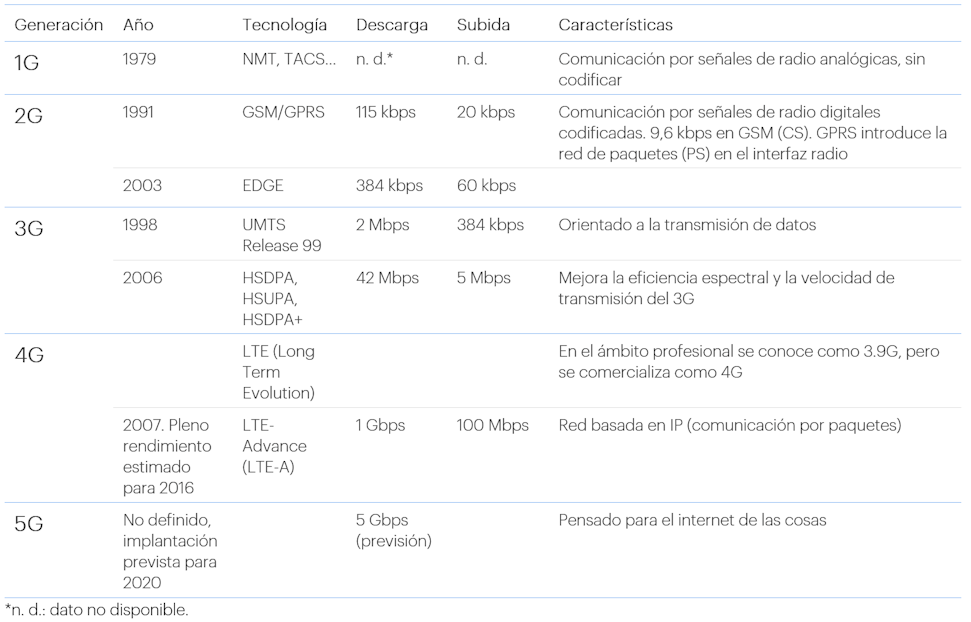Article
4G, LTE-A and the release of the digital dividend

Telecommunications providers must clearly interpret the new situation so they may take advantage of all the opportunities that appear

The table at the top summarizes, perhaps in an excessively simplified manner, the different generations of cell phones. From one generation to the next, there are net qualitative leaps, but as can be noted in each one, the constant introduction of new technologies allows the progressive implementation of improvements.
Currently, most users in Spain use 3G networks to communicate, and these networks reach 90% of the population. However, certain users remain connected to 2G networks (these are even more common in developing countries), and some already have access to the 4G network.
However, an important clarification must be made. The International Telecommunications Union (ITU), the body that handles this matter, established the connectivity specifications that 4G should meet. The main one was that, in ideal conditions, a download speed of 1 Gbps should be reached. However, given the technical difficulties in achieving these results, the standards body agreed to reserve the name Long Term Evolution (LTE) for a less ambitious goal that was more accessible in the short term, and use Long Term Evolution Advance (LTE-A) for the initially specified standard. Therefore, LTE is an improvement over 3G (which some refer to as 3.9G), while LTE-A marks the actual entry into the 4G generation. Unfortunately, the industry pushed to be permitted to advertise LTE as 4G and the ITU agreed, which has caused a lot of confusion. The table should help clarify these concepts.
In any case, connection speeds do not depend only on the transmission technology. They depend a great deal on the bandwidth available, among other factors. The digital dividend, which should have entered into force on January 1st of this year and was pushed back to April 1st at the request of television companies, has the aim of releasing the radio electric spectrum so cell phone operators have access to the bandwidth that is needed for the improvements promised by 4G to be truly effective. As a result, DTT platforms were required to abandon the 800 MHz frequency band that allows more coverage inside buildings and a longer reach. There are other resources available to increase speed, such as the option of sending and receiving through several antennas at a time, or the carrier aggregation concept that allows using carrier waves of different frequency bands in a single communication.
These conditioning factors, and others that this article does not describe in detail, are what allow Movistar (currently in Madrid and Barcelona) and Vodafone (in Madrid, Barcelona, and Valencia, for now) to have LTE-A networks (remember, with supposed speeds of 1 Gbps) with download speeds of only 300 Mbps.
Telecommunications providers are working hard to implement 4G networks (LTE or LTE-A) and reach speeds closer to what is conceptually possible, while terminal manufacturers launch models that are adapted to this technology, because without the devices, the networks would be useless. The delay in releasing the digital dividend, combined with other issues, has pushed back Spain’s access to 4G (despite the country being a pioneer in the implementation of 3G), compared to North America, the rest of Europe, and Southeast Asia. However, our nation’s leading telecommunications providers are expected to implement LTE-A in every city with over 1,000 residents by 2016.
In this field, as in all others, the demand for new services and features is the main driver of progress. The abundance of smartphones and the success of social networks drove the use of 3G. Since then, the number of connected devices has risen incessantly, and more multimedia content (and of greater quality) is being shared. All of this results in the exponential growth of data traffic. Deploying 4G will make it possible to provide customers with high-quality services at high transmission speeds, and it will also ease the congestion of 3G nodes in high-traffic areas.
Telecommunications providers, device manufacturers, and service providers must clearly interpret the new situation in order to define and manage network deployments, optimize the equipment as well as the radio and transmission network, analyze terminal performance, and develop the commercial and service offering. They must also have a vision for the short term (updating and expanding equipment), medium term (deploying new locations), and long term (future technologies) to take advantage of the opportunities that appear.

